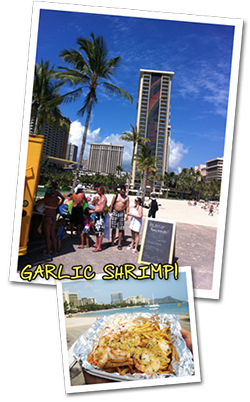
 Modern cuisine of Hawaii is a fusion of many cuisines
brought by multi-ethnic immigrants to the islands, particularly
of American, Chinese, Filipino, Japanese, Korean, Polynesian and
Portuguese origins, and including food sources from plants and a
nimals imported for Hawaiian agricultural use from all over the
world. Modern cuisine of Hawaii is a fusion of many cuisines
brought by multi-ethnic immigrants to the islands, particularly
of American, Chinese, Filipino, Japanese, Korean, Polynesian and
Portuguese origins, and including food sources from plants and a
nimals imported for Hawaiian agricultural use from all over the
world.
Many local restaurants serve the ubiquitous plate lunch
featuring the Asian staple, two scoops of rice, a simplified
version of American macaroni salad (consisting of macaroni
noodles and mayonnaise), and a variety of different toppings
ranging from the hamburger patty, a fried egg, and gravy of a
Loco Moco, Japanese style Tonkatsu or the traditional lu'au favorite, Kalua Pig.
 FEATURED | FOOD TRUCKS FEATURED | FOOD TRUCKS
Gilligan's Beach Shack
Gilligan's Beach Shack is the brightest food truck in Waikiki with the most amazing views of Diamond Head. Open Daily serving up delicious beach food favorites. Wiped out after a day of hanging ten or sunning on Waikiki Beach? Try the popular Garlic Shrimp, Grilled Mahi Mahi Fish Tacos, Fish & Chips, or Coconut Shrimp with Guava Jelly. Located in front of the Duke Kahanamoku Beach near the Hilton Hawaiian Village Lagoon.
Menu
Garlic Shrimp
Shrimp & Mahi Combo
Fish Taco's
Fish and Chips
Surf and Turf
Fisherman's Platter
Coconut Shrimp
Shave Ice
and more...
HAWAII REGIONAL CUISINE
In August 1991, a group of chefs in
Hawaii came together to form an organization to create a new American regional cuisine, highlighting
Hawaii's locally grown ingredients and diverse ethnic styles. In 1992, twelve chefs including
Sam Choy, George Mavrothalassitis, Alan Wong, and Roy Yamaguchi, came together to sponsor a cookbook
to be sold for charity.
The goal of this new group of chefs was to link local agriculture with
the restaurant industry, making Hawaii Regional Cuisine a reflection of the community. For this,
they took an uninspired international hotel cuisine based on imported products and replaced it
with a cuisine based on locally grown foods.
ISLAND FOOD 101
Island foods extend far beyond coconut
and pineapples, Hawaii's native dishes
robust with flavor and prepared with the freshest ingredients from both land and
sea, should be on the checklist of foodies who are looking to try something
new and authentic.
Since it is a group of islands, it's only natural that Hawaii's waters are
bountiful with a variety of seafood, and sushi and sashimi lovers will be in
heaven here. Hawaii's residents consume the most fish in the nation, a majority
of it prepared raw as poke (pronounced poe-kay). The dish dates back to ancient
Hawaii, when raw fish was seasoned with sea salt and crushed kukui nuts, and cut
into bite-sized pieces or served whole. Poke is now a staple of the island table,
usually prepared with fresh 'ahi (yellow fin tuna) and mixed with soy sauce, onions
chili peppers, limu (seaweed) or wasabi (Japanese horseradish). Other gems from the
sea such as octopus, aku (skipjack), mussels and even raw crab can be made into poke.
Most restaurants and bars offer poke on their pupu (appetizer) menu, and it can be found
in the seafood section of grocery store and served at some of the lu'au shows. It's great
with a cold beer and its flavor and texture will wow even the most discriminate seafood
connoisseur.
For many visitors who sample Hawaiian food, Kalua pig is the hands down favorite. Traditionally
served at a lu'au, the pig is cooked in an imu (underground oven) all day long yielding juicy
pork with a distinct, smoky flavor. Served shredded, it's a favorite of locals too, and the dish
is offered as a main course at many "plate lunch" eateries. Its popularity has led to several
area chefs to incorporate it into sandwiches, quesadillas and even tacos on their menus.
Real Hawaiian food can't be discussed without a mention of poi. While many have heard of it,
they may or may not understand what it is made from: it comes from the taro root, a starch staple
throughout the Pacific, and it is steamed, mashed and mixed with water into a smooth, thick
paste. Hawaiians have been eating it for centuries, and it's been touted for being low in calories
and nutritious. Poi is an acquired taste, and a sprinkling of sugar makes it palatable for novices.
Dig in and discover what 'ono (delicious) means!
|
|
Best Places to Eat in Waikiki
Best places to eat in Waikiki and all across Oahu!
View Restaurant Listings now
|












 Modern cuisine of Hawaii is a fusion of many cuisines
brought by multi-ethnic immigrants to the islands, particularly
of American, Chinese, Filipino, Japanese, Korean, Polynesian and
Portuguese origins, and including food sources from plants and a
nimals imported for Hawaiian agricultural use from all over the
world.
Modern cuisine of Hawaii is a fusion of many cuisines
brought by multi-ethnic immigrants to the islands, particularly
of American, Chinese, Filipino, Japanese, Korean, Polynesian and
Portuguese origins, and including food sources from plants and a
nimals imported for Hawaiian agricultural use from all over the
world.  FEATURED | FOOD TRUCKS
FEATURED | FOOD TRUCKS

